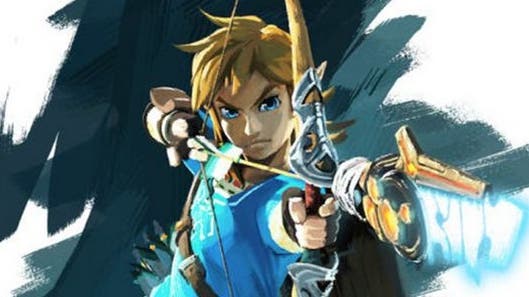Technology and nature have a strange relationship in Zelda: Breath of the Wild
Slate expectations.
I bounced off the latest Zelda, Breath of the Wild, quite quickly when it first came out, but over the last few weeks a very specific element of the game has been bringing me back. It's an animation that plays at certain moments, most commonly when you climb a new tower and unlock a new part of the game's gigantic map of Hyrule.
I'm sure the thrill of achievement has something to do with it, but the animation itself works a strange magic on me regardless. It seems to hint at deep mysteries, or perhaps yet deeper revelations that lie just beyond my reach.
Here's what happens. Link's big gadget in the game is the Sheikah Slate, a kind of ancient iPad that does various useful things over the course of an adventure that I am still nowhere near completing. To unlock a tower, Link must first work out a way to climb it, and then, once at the top, must essentially download the tower's information, by putting the slate into a raised platform that sits below a stalactite. The slate always makes the sound of rock on rock when it is docked, which is weird enough in itself because it has a glossy screen and all that Apple jazz. Then this strange and fascinating animation kicks off. Music starts to build and the stalactite starts to flicker with what is unmistakably code, racing down over its surface. Because this is a stalactite, a drop of glowing dew starts to form at the very tip, and there is an overwhelming sense that this dew is made of the scrolling code, and is filled with it, in fact. Eventually, the dew falls from the stalactite and splashes onto the face of the slate. Packages have been delivered, or whatever the technical term is. It's a wonderful moment in its very refusal to become a metaphor. Instead, in this world, and quite plainly stated, digital technology is also the stuff of geology, of elements, of nature itself.

A big part of the reason that this strikes me as being so fascinating, I think, is because it lays bare a truth about the game that is easy to see but hard to believe. It essentially unsuspends a central disbelief that most fantasy games rely upon. Zelda games have often brushed up against technology - I'm thinking, for example, of the camera from The Wind Waker, which in my memory at least is a wonderful brass and wood confection straight out of the world of Fox Talbot. (And Tom Phillips has just reminded me of the Ancient Robots from Skyward Sword.) But Breath of the Wild is the first Zelda, as far as I can remember, to concern itself with digital technology. Sure, there were those Daft Punk rift-beings who fizzed and popped across the screen in some of Twilight Princess's colder moments, but they felt like an incursion from outside of Hyrule. (I can't remember how the plot actually tied up, come to think of it. Maybe they weren't from outside at all.)
But Breath of the Wild states, with every time you update your Slate, that this world which, for a Zelda game, is unprecedented in its embrace of nature, is also underneath it all, in some ancient and primal way, a digital artefact. Stalactites flood with code, and dew can allow you to download the maps that the rocks themselves seem to carry within them. (Feeble neurological aside because why not: this reminds me of the maps of the human body that Charles Scott Sherrington discovered the human brain carries within it. I am pretty sure it was Sherrington anyway.)
The suggestion, I guess, is that Zelda's wildernesses have always been digital artefacts and its designers have always had to navigate this strange truth. And this plays out on several levels in Breath of the Wild. The constellations sketched out on the walls of the Shrines you visit look a lot like the golden paths of circuit boards. And those Shrines themselves, which seem to initially play into a classic fantasy divide - the world above is ragged and wild, but down here everything is smooth and sharp-edged and designed and crafted to be a perfect puzzle to delight for a few coherent minutes - ultimately hint at a deeper truth. The ultimate joke is that the wilderness above is equally designed, and equally solvable. There's no mountain in this Zelda that doesn't have an optimal path built into its tumbled rocks.
So if this is the Zelda game that tackles nature, it tackles it in a very playful, self-aware manner. The game is the landscape, it says, and the landscape is code.
Even so, buried deeper, the more I return to that stalactite that scrolls with code, the more I feel I can just about sense something rather revealing about the way that Nintendo has always looked at technology. Technology, for Nintendo, has never been separate from the world, it has never been a thing purely in itself. This is a publisher that makes cardboard toys that interface with digital tablets, and that once thought of publishing a Vitality Sensor.

Or rather, maybe it's best to turn it on its head: Nintendo has always been willing to look at technology in the context of the wider world, and to examine the way that things other than digital technology can be brought to bear on the games and toys it makes, whether that's mechanics in Labo, the human body in Wii Fit or the seasonal calendar that powers the dreamy tidal dramas of Animal Crossing. It's there explicitly in the latest Zelda, but it's always been there implicitly. And for a few seconds when I climb a tower and reach the top, I get to glimpse what feels like a very ancient magic of connectedness.










